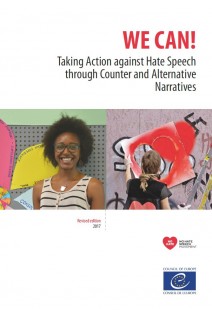
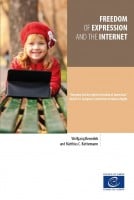
Freedom of expression and the Internet (2014)
- Exclusivité web !


Combating hate speech offline and online: a new tool to help young people and educators to confront, dismantle and replace hateful narratives.
Online hate speech has become a major form of human rights abuse, with serious, sometimes tragic consequences, both online and offline. Hate speech cannot be allowed to proliferate without being challenged and exposed in its nature: prejudicial views on social groups combined with fake news which feed phobias and fears, seem attractive as narratives. Narratives give a meaning to information presented because they connect with what people believe, or want to believe in.Their widespread presence online accredits their claims for legitimacy.
But narratives are rarely the truth and never the whole truth. When they are used to oppress people, as in hate speech, the fundamentals of a pluralistic and democratic society are undermined, and the lives and dignity of people are at risk.
Counter narratives are thus needed to discredit and deconstruct the narratives on which hate speech is based. Alternative narratives are also needed to reinforce positive values and perspectives which support human rights and democratic citizenship, such as solidarity, respect for diversity, freedom and equality. Young people need to occupy online public space with positive narratives based on hope and love.
This manual presents communicative and educational approaches and tools for youth and other human rights activists to develop their own counter and alternative narratives to hate speech. It is designed for working with young people from the age of 13, and is based on the principles of human rights education and youth participation.
Anyone can take action against speech. By providing insights into hate speech and human rights, and a methodology for producing counter narratives, We Can makes that action easier, more effective and positive.
The Council of Europe launched the No Hate Speech Movement campaign to mobilise young people for human rights online and to combat hate speech. Education plays a central role in the campaign. This manual complements Bookmarks - A manual for combating hate speech online through human rights education, also published by the Council of Europe.
TABLE OF CONTENTS
CHAPTER 1 – THE MANUAL
1.1. Introducing basic concepts
1.2. The need for the manual
1.3 Using narratives to address hate speech
1.4 Objectives of the manual
1.5 Intended users of the manual
1.6 Educational approach
1.7 The No Hate Speech Movement campaign
1.8 Structure of the manual
CHAPTER 2 – HATE SPEECH
2.1 Defining hate speech
2.2 Categories for social analysis of hate speech
2.3 Who is targeted by hate speech?
2.4 Two examples of hate speech in Europe
CHAPTER 3 – HATE SPEECH ONLINE AND SOCIAL MEDIA
3.1 Communication and Web 2.0
3.2 Social media approaches towards hate speech
3.3 The role of Internet literacy
3.4 Campaigning through social media
CHAPTER 4 – NARRATIVES
4.1 Why talk about narratives?
4.2 So, what’s the story?
4.3 Narratives as frameworks for action: two examples
CHAPTER 5 – COUNTER AND ALTERNATIVE NARRATIVES
5.1 Introducing counter and alternative narratives
5.2 Counter or alternative narratives?
5.3 Counter messaging: occupying public space
5.4 Alternative narratives: a path to changing established discourses
5.5 A human rights-based approach to narratives
5.6 Narratives as one of the instruments in the toolbox
CHAPTER 6 – PREPARING FOR ACTION
6.1 We can do it!
6.2 Responding through human rights
6.3 Developing competences through action
6.4 Challenges when campaigning offline and online
6.5 Types of engagement
6.6 Emotions, safety and well-being
6.7 The power of language
6.8 Ensuring legitimacy
6.9 Strengthening social support for your action
6.10 Considering human and material resources
6.11 Finding more information
CHAPTER 7 – DOING IT STEP-BY-STEP
7.1 Phase 1: Assess the oppressive narrative
7.2 Phase 2: Design the counter narrative
7.3 Phase 3: Implement the counter narrative
7.4. Phase 4: Monitor and evaluate the counter narrative
APPENDICES
Appendix 1: Frequently Asked Questions (FAQs)
Appendix 2: Universal Declaration of Human Rights (Summary)
Appendix 3: European Convention on Human Rights (Summary)
Appendix 4: Sample Workshop Outline
Appendix 5: Annotated Resources
Appendix 6: Glossary
Télécharger un extrait (1000)


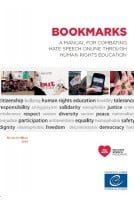
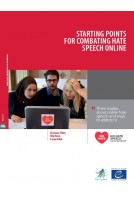

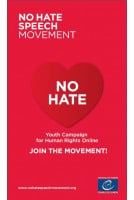



Combating hate speech offline and online: a new tool to help young people and educators to confront, dismantle and replace hateful narratives.
Online hate speech has become a major form of human rights abuse, with serious, sometimes tragic consequences, both online and offline. Hate speech cannot be allowed to proliferate without being challenged and exposed in its nature: prejudicial views on social groups combined with fake news which feed phobias and fears, seem attractive as narratives. Narratives give a meaning to information presented because they connect with what people believe, or want to believe in.Their widespread presence online accredits their claims for legitimacy.
But narratives are rarely the truth and never the whole truth. When they are used to oppress people, as in hate speech, the fundamentals of a pluralistic and democratic society are undermined, and the lives and dignity of people are at risk.
Counter narratives are thus needed to discredit and deconstruct the narratives on which hate speech is based. Alternative narratives are also needed to reinforce positive values and perspectives which support human rights and democratic citizenship, such as solidarity, respect for diversity, freedom and equality. Young people need to occupy online public space with positive narratives based on hope and love.
This manual presents communicative and educational approaches and tools for youth and other human rights activists to develop their own counter and alternative narratives to hate speech. It is designed for working with young people from the age of 13, and is based on the principles of human rights education and youth participation.
Anyone can take action against speech. By providing insights into hate speech and human rights, and a methodology for producing counter narratives, We Can makes that action easier, more effective and positive.
The Council of Europe launched the No Hate Speech Movement campaign to mobilise young people for human rights online and to combat hate speech. Education plays a central role in the campaign. This manual complements Bookmarks - A manual for combating hate speech online through human rights education, also published by the Council of Europe.
Attention, en vertu de nos conditions générales de vente, l'achat des PDF/epub est réservé aux particuliers.
